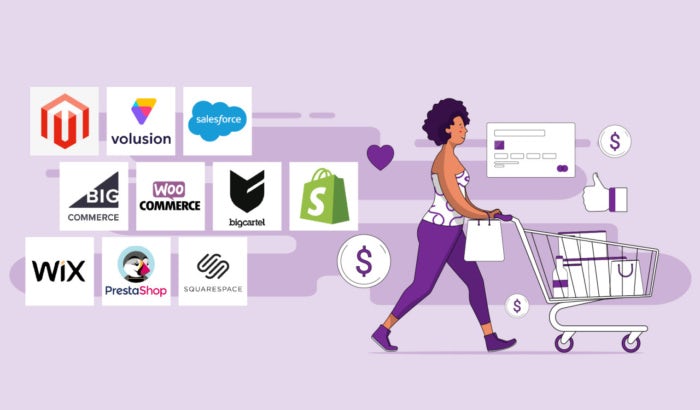You want to build an online store, but with so many ecommerce platforms on the market, you’re not sure which one to choose for your business?
Well, search no further.
Even before the pandemic, ecommerce has established itself as the driving force of business nowadays. For that reason, when you shop for an online shopping platform, it’s prudent to choose a solution that would serve your business as it expands.
Does Expensive mean Quality for ecommerce platforms? Not necessarily, as it all comes down to your business requirements and some important factors that we’ll discuss in this guide.
That’s why we rounded up the most reliable ecommerce platforms that meet different business and user needs – big or small, beginner or pro.
[toc exclude=“last”]
What You Need from the Best eCommerce Platforms
When hunting for the best ecommerce platform, you’re putting your business needs and your target customers as a top priority. Accordingly, there are a few key factors you need to keep in mind.
1. Ease of Use
Your website is a mirror of how successful your business is and the first visual impression given to your customers. If they don’t like the way it looks or find it hard to browse – they’ll leave. It’s that simple.
That’s why it’s important to choose a platform that you can easily use to design (e.g., intuitive drag-and-drop editor) and set up your shop. You should also pick a solution that provides you with a wide range of unique templates that can capture the feel of your brand and improve your UX design.
2. Features and Marketing Integrations
If you want to create a new revenue stream and expand your online business, it’s difficult to achieve that through one software package.
Social media has become the backbone of marketing in today’s ecommerce world, so you want a platform that can seamlessly connect you with different marketplaces, social media channels, and apps.
The type and amount of features offered by an ecommerce app should correspond to your business needs. It’s best to pick a platform that offers a wide range of features (e.g., plugins, shipping, managing goods, analytics, business tools, email marketing options, POS system, etc.).
3. Device Compatibility
Mobile commerce has become a vital channel for ecommerce stores. Did you know that the global mobile shopping revenue exceeded $3 billion in 2021? Your customers have their smartphones in their hands most of the time and they find it easier and more convenient to shop online through their phones than laptops or desktops.
Make sure that the ecommerce platform you choose is compatible with different operating systems and responsive on all screens and devices.
4. Payment Methods and Security
Before you decide on an ecommerce solution, you need to make a quick geo-location study to discover what online payment methods are available in the countries your customers are located.
As for your customers, it’s important to provide them with easy, diverse, and secure payment options to ensure their personal and financial data is protected.
Therefore, look for a platform that offers multiple payment methods that are safe and convenient to your target customers.
5. SEO-Friendly
In order for your online business to reach a wide audience quickly and easily, SEO is an essential element to consider. You need to be sure that your chosen ecommerce platform is SEO-friendly and optimized for popular search engines like Google.
6. Support
One of the strongest points of having an online store is that it’s 24/7 open for customers. But this also means that people might look for support for your products/services at any time of day. Your ecommerce platform should provide enough tools to handle different support options at different hours – live chat software, chatbots, contact forms, social media integrations, etc.
In addition, if you aren’t tech-savvy and need assistance building and managing your online store, you should go for a provider that comes with excellent customer support.
7. Pricing
eCommerce platforms have different pricing systems. Some of them are very expensive, while others are cheap. Some platforms offer a monthly or an annual billing system, while others only let you charge your clients per transaction. In any case, it’s wise to go for an ecommerce software that fits your budget.
Here are our top picks of the best ecommerce platforms:
1. Shopify
Shopify is the most popular all-in-one SaaS ecommerce platform. It offers more than 80 professional and mobile-friendly themes – some even available for free. Templates are well-organized and easy to browse through. Each theme is equipped with its own set of customizable tools that you can tailor to your brand.
If you’re a beginner, you won’t have trouble using Shopify’s drag-and-drop editor. You can effortlessly personalize and customize sections. There’s also an onboarding wizard to guide you through the store building process like adding products, payment options, connecting domains, and more.
Shopify is also a hosted platform on Google Cloud, which means that it’s fast and you won’t have to deal with any server management or maintenance. Shopify’s slick mobile app will additionally help you control your store on the go.
Marketing-wise, you’ll get SEO and marketing tools, blogging platform, the ability to use your own domain name, and social media integration. You can even connect your Shopify inventory with Amazon and eBay.
Other notable ecommerce features include inventory management, synchronizing your online and physical stores via POS system, discounts and coupons, automated store emails, one-click checkouts, automatic tax calculation, and Google Analytics. You can also make your store available in multiple languages, and get access to at least 5,000 third-party apps.
Fraud Analysis is another excellent feature you can use to identify any suspicious or fraudulent orders. Automatic shipping rate calculation is available for specific products and you can easily create customer reports. Shopify has its own payment gateway and supports PayPal Checkout as well as 70 other payment options. Still, keep in mind some transaction fees may be applied depending on the chosen method.
Shopify is reasonably priced and comes in three tiers, but keep in mind you might incur extra charges for add-ons and premium extras. You can choose to subscribe on a monthly or annual basis.
While there’s a 14-day free trial to evaluate the service, Shopify doesn’t offer refunds once you sign up. Customer support is available 24/7 through live chat, email, ticket, and phone callbacks. There’s also a comprehensive Knowledgebase, community forum, tutorials, and FAQ sections.
| Pros | Cons |
| ● Unlimited bandwidth, products, and disk space | ● No refund policy |
| ● 14-day free trial | ● Charges transaction fees for using external payment gateways |
| ● Wide range of applications, extensions, and ecommerce features | ● Can get expensive with higher plans and paid add-ons |
| ● User-friendly drag-and-drop editor and polished mobile app | |
| ● 24/7 customer support via multiple channels |
2. Wix
Wix was originally launched in 2006 and was known as Flash Editor. Today, it serves more than 200 million users around the world. Wix is a well-known website building and hosting platform. It offers a ton of features for easily creating an impressive online store.
Through Wix’s sleek and user-friendly dashboard, you can manage all aspects of your online store. This includes managing and fulfilling orders, viewing your website analytics, managing payments, and. You can also take advantage of the Wix Owner app which is available on iOS and Android.
The Wixsite builder relies on a simple drag-and-drop procedure to easily build your online store from scratch. In addition, you can choose from more than 500 templates which are completely free with all plans. There’s even a free package with limited features but just enough if you’re starting up a new small business.
Thanks to Wix’s multiple integrated points of sale, you can sell your products through Facebook, Instagram, Amazon, and eBay. You can further promote your business with Wix’s built-in marketing tools.
Wix also helps you go global with your online store through advanced SEO optimization tools, multilingual storefront, and a built-in currency converter. Wix supports numerous payment methods which can also differ depending on the location of your target audience.
Wix’s support is available 24/7. If you opt in for the VIP plan, you get to enjoy premium support without having to wait in a queue to get connected to an agent.
| Pros | Cons |
| ● Drag-and-drop website builder | ● Limited support channels |
| ● Free plan available | ● You have to pay for premium support |
| ● 500+ templates | |
| ● A ton of built-in features |
3. BigCommerce
BigCommerce was founded in 2009 and serves companies in more than 150 countries. BigCommerce is widely popular among large businesses, owing to its user-friendly interface and high customization options. The platform is developed to give you ultimate control over your day-to-day online store management process.
In comparison with other platforms, BigCommerce’s prices are a bit on the expensive side. However, all price plans come with unlimited products, storage, bandwidth, and staff accounts. BigCommerce also offers a 15-day free trial so you can test the waters before making any financial commitments.
In addition, all three plans offer multiple sales channels (online storefront, POS, Amazon, eBay, Walmart, etc.) and social media integration (Facebook, Instagram, Google shopping, etc.). They also include a mobile-responsive website plus a smartphone app.
The day-to-day operations of your online business such as traffic analysis and stock monitoring can be managed very easily with BigCommerce but the behind-the-scenes work can be a little tricky. Nevertheless, BigCommerce’s support team is available 24/7 through phone, live chat, and ticket in order.
| Pros | Cons |
| ● Unlimited products, storage, bandwidth, staff accounts | ● Slightly expensive |
| ● Accepts multiple payment methods and currencies | ● Customization of website needs technical skills |
| ● Supports multiple sales channels and social media integrations | |
| ● 15-day free trial |
4. Magento
Magento was officially launched in 2008. It was later bought by eBay and subsequently sold to Adobe. On a yearly basis, the ecommerce platform processes more than $100 billion in gross merchandise volume.
Downloading and installing Magento on your own server is free of charge (community or basic version). However, Magento also offers a self-hosted service (Enterprise version) which you don’t need to install. The price for this service depends on the size of your online business. The platform itself is highly user-friendly and doesn’t require advanced technical skills to manage.
If you compare Magento with Shopify, you’ll find that the former is also hosted on the cloud using AWS and Azure. This makes it highly scalable and guarantees a reliable performance for your online store. No matter where your customers are located, they’ll experience high loading speeds, which is always good for business.
Magento comes packed with features, including inventory management, multiple payment options, built-in multilingual support, SEO tools, order processing, and many more. The platform is also optimized for all devices (desktop, laptops, mobile phones, tablets, etc.).
Getting help in Magento is quite easy, thanks to its large community. Through it, you can get answers to your questions from developers for free or have them help you out for a fee. Magento also has its own marketplace where you can get a wide variety of themes and choose from over 5000 extensions to boost your website.
| Pros | Cons |
| ● Ability to handle very large shops with lots of products | ● The Enterprise version is very expensive |
| ● Free community version | ● Themes and extensions are paid for separately |
| ● Feature-rich |
5. WooCommerce
WooCommerce started in 2008 as an open-source commerce solution built on WordPress. Back then, the company was called WooThemes. It wasn’t until 2017 that the developers decided to focus exclusively on ecommerce and changed the name to WooCommerce.
The platform targets mostly small-to-medium businesses. If you already have a WordPress website, setting up WooCommerce should be quite easy and straightforward. Woo’s interface is quite basic and doesn’t require a tech expert to launch a beautiful online store.
The WooCommerce plugin itself is free, but in order to have a full-on online store with all functionalities, you’ll need to purchase extensions from the WooCommerce marketplace. However, there are some free add-ons available as well, and even the paid ones are reasonably priced.
There are numerous payment methods that WooCommerce supports. These include credit/debit cards, bank transfers, checks, and cash on delivery, but other options as well – PayPal, Stripe, Square, Amazon Pay, Apple Pay, and more.
Reads More: 7 Important Things to Consider Before Buying A Refurbished Computers
Through WooCommerce’s user-friendly dashboard you can easily update products and fulfill orders. Save time by using the dashboard’s automated tax calculations, get live shipping rates from leading carriers, and even print labels from home.
You can integrate multiple marketing channels with WooCommerce including Google Shopping, Facebook, and several others. Woo is also compatible with all devices and has a mobile application for both iOS and Android.
| Pros | Cons |
| ● Built on WordPress | ● Requires WordPress knowledge |
| ● Free if you have WordPress site | ● WooCommerce updates don’t always work with WordPress |
| ● Lots of free and paid extensions | |
| ● Highly user-friendly interface |
Which Ecommerce Platform Is Right for You?
As you can see, no ecommerce platform is flawless, and the market is highly competitive in order to cater to different business needs. The prices range from a few bucks per month to chewing a hole in your wallet. However, as previously mentioned, choosing the right ecommerce platform rests on the nature of your business and its demands.
If you’re still in doubt and not sure what to choose from the listed platforms, this table will help you out.
| Platform | Best for |
| Shopify | Beginners with little or no technical background. Also small businesses and startups looking for an all-purpose platform. |
| Wix | Individual sellers and SMBs looking for a versatile and easy-to-use ecommerce builder.
|
| BigCommerce | Tech-advanced users and online retailers with large product catalogues. |
| Magento | Medium to large stores looking for scalability and driving sales. |
| WooCommerce | Small to medium business on budget, and users looking for building an online store using WordPress. |
Do you have more questions? Let’s discuss in the comments section below.





Fantastic beat ! I wish to apprentice while you amend your web site, how could i subscribe for a blog website? The account helped me a acceptable deal. I had been a little bit acquainted of this your broadcast offered bright clear idea|
Hi there this is kind of of off topic but I was wanting to know if blogs use WYSIWYG editors or if you have to manually code with HTML. I’m starting a blog soon but have no coding experience so I wanted to get guidance from someone with experience. Any help would be greatly appreciated!|